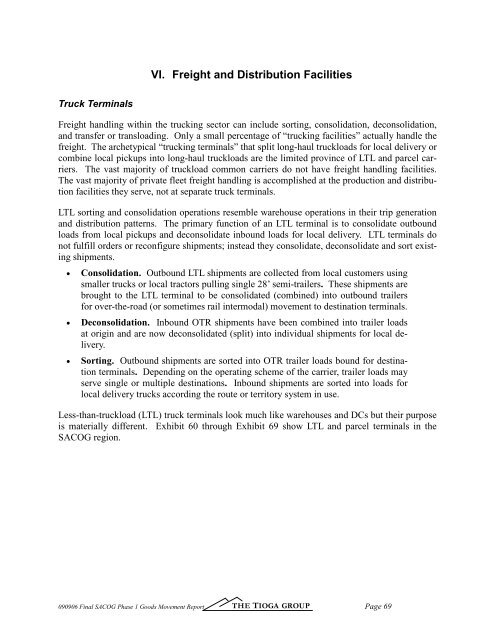Final SACOG Phase 1 Goods Movement Report
Final SACOG Phase 1 Goods Movement Report
Final SACOG Phase 1 Goods Movement Report
You also want an ePaper? Increase the reach of your titles
YUMPU automatically turns print PDFs into web optimized ePapers that Google loves.
VI. Freight and Distribution Facilities<br />
Truck Terminals<br />
Freight handling within the trucking sector can include sorting, consolidation, deconsolidation,<br />
and transfer or transloading. Only a smal percentage of “trucking facilities” actualy handle the<br />
freight. The archetypical “trucking terminals” that split long-haul truckloads for local delivery or<br />
combine local pickups into long-haul truckloads are the limited province of LTL and parcel carriers.<br />
The vast majority of truckload common carriers do not have freight handling facilities.<br />
The vast majority of private fleet freight handling is accomplished at the production and distribution<br />
facilities they serve, not at separate truck terminals.<br />
LTL sorting and consolidation operations resemble warehouse operations in their trip generation<br />
and distribution patterns. The primary function of an LTL terminal is to consolidate outbound<br />
loads from local pickups and deconsolidate inbound loads for local delivery. LTL terminals do<br />
not fulfill orders or reconfigure shipments; instead they consolidate, deconsolidate and sort existing<br />
shipments.<br />
<br />
<br />
<br />
Consolidation. Outbound LTL shipments are collected from local customers using<br />
smaller trucks or local tractors puling single 28’ semi-trailers. These shipments are<br />
brought to the LTL terminal to be consolidated (combined) into outbound trailers<br />
for over-the-road (or sometimes rail intermodal) movement to destination terminals.<br />
Deconsolidation. Inbound OTR shipments have been combined into trailer loads<br />
at origin and are now deconsolidated (split) into individual shipments for local delivery.<br />
Sorting. Outbound shipments are sorted into OTR trailer loads bound for destination<br />
terminals. Depending on the operating scheme of the carrier, trailer loads may<br />
serve single or multiple destinations. Inbound shipments are sorted into loads for<br />
local delivery trucks according the route or territory system in use.<br />
Less-than-truckload (LTL) truck terminals look much like warehouses and DCs but their purpose<br />
is materially different. Exhibit 60 through Exhibit 69 show LTL and parcel terminals in the<br />
<strong>SACOG</strong> region.<br />
090906 <strong>Final</strong> <strong>SACOG</strong> <strong>Phase</strong> 1 <strong>Goods</strong> <strong>Movement</strong> <strong>Report</strong> THE TIOGA GROUP<br />
Page 69
















